8-ortopleks
|
8-ortoplex Octacross |
|
|---|---|
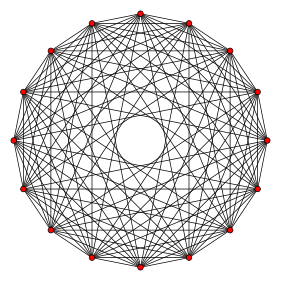 Projekcja ortogonalna wewnątrz wielokąta Petriego |
|
| Typ | Zwykły 8-politop |
| Rodzina | ortopleks |
| Symbol Schläfliego |
{3 6 ,4} {3,3,3,3,3,3 1,1 } |
| Diagramy Coxetera-Dynkina |
|
| 7 twarzy | 256 {3 6 } |
| 6-twarzy | 1024 {3 5 } |
| 5 twarzy | 1792 {3 4 } |
| 4 twarze | 1792 {3 3 } |
| Komórki | 1120 {3,3} |
| Twarze | 448 {3} |
| Krawędzie | 112 |
| Wierzchołki | 16 |
| figura wierzchołka | 7-ortopleks |
| wielokąt Petriego | sześciokąt |
| grupy Coxetera |
do 8 , [3 6 ,4] re 8 , [3 5,1,1 ] |
| Podwójny | 8-sześcian |
| Nieruchomości | wypukły , polytope Hannera |
W geometrii 8 -ortoplex lub 8- cross polytope jest regularnym 8-polytopem z 16 wierzchołkami , 112 krawędziami , 448 trójkątnymi ścianami , 1120 czworościennymi komórkami , 1792 5 komórkami 4 ścianami , 1792 5 ścianami , 1024 6 ścianami i 256 7 twarzy .
Ma dwie konstruktywne formy, pierwsza jest regularna z symbolem Schläfliego {3 6 ,4}, a druga z naprzemiennie oznaczonymi (szachownicowymi) fasetami, z symbolem Schläfliego {3,3,3,3,3,3 1,1 } lub symbol Coxetera 5 11 .
Jest częścią nieskończonej rodziny polytopów, zwanych cross-polytopami lub ortopleksami . Podwójny polytope to 8- hipersześcian lub ośmiokąt .
Alternatywne nazwy
- Octacross , wywodzący się z połączenia nazwy rodziny cross polytope z oct dla ośmiu (wymiarów) w języku greckim
- Diacosipentacontahexazetton jako 256- fasetowany 8-polytop (polyzetton)
Jako konfiguracja
Ta macierz konfiguracji reprezentuje 8-ortopleks. Wiersze i kolumny odpowiadają wierzchołkom, krawędziom, ścianom, komórkom, 4-ścian, 5-ścian, 6-ścian i 7-ścian. Liczby po przekątnej mówią, ile każdego elementu występuje w całym 8-ortopleksie. Liczby niediagonalne mówią, ile elementów kolumny występuje w elemencie wiersza lub na nim.
Ukośne numery wektorów f są uzyskiwane za pomocą konstrukcji Wythoffa , dzieląc pełny porządek grupowy rzędu podgrup przez usunięcie poszczególnych luster.
| B8 _ | k-twarz | f k | F0 | f 1 | f 2 | fa 3 | f 4 | f 5 | f 6 | f 7 | k -figura | notatki | |
|---|---|---|---|---|---|---|---|---|---|---|---|---|---|
| B7 _ | ( ) | F0 | 16 | 14 | 84 | 280 | 560 | 672 | 448 | 128 | {3,3,3,3,3,4} | B 8 / B 7 = 2^8*8!/2^7/7! = 16 | |
| A 1 B 6 | {} | f 1 | 2 | 112 | 12 | 60 | 160 | 240 | 192 | 64 | {3,3,3,3,4} | B 8 /A 1 B 6 = 2^8*8!/2/2^6/6! = 112 | |
| 2 B 5 _ | {3} | f 2 | 3 | 3 | 448 | 10 | 40 | 80 | 80 | 32 | {3,3,3,4} | B 8 /A 2 B 5 = 2^8*8!/3!/2^5/5! = 448 | |
| A 3 B 4 | {3,3} | fa 3 | 4 | 6 | 4 | 1120 | 8 | 24 | 32 | 16 | {3,3,4} | B 8 /A 3 B 4 = 2^8*8!/4!/2^4/4! = 1120 | |
| 4 B 3 _ | {3,3,3} | f 4 | 5 | 10 | 10 | 5 | 1792 | 6 | 12 | 8 | {3,4} | B 8 / A 4 B 3 = 2^8*8!/5!/8/3! = 1792 | |
| 5 B 2 _ | {3,3,3,3} | f 5 | 6 | 15 | 20 | 15 | 6 | 1792 | 4 | 4 | {4} | B 8 /A 5 B 2 = 2^8*8!/6!/4/2 = 1792 | |
| 6 A 1 _ | {3,3,3,3,3} | f 6 | 7 | 21 | 35 | 35 | 21 | 7 | 1024 | 2 | {} | B 8 /A 6 ZA 1 = 2^8*8!/7!/2 = 1024 | |
| 7 _ | {3,3,3,3,3,3} | f 7 | 8 | 28 | 56 | 70 | 56 | 28 | 8 | 256 | ( ) | B 8 /A 7 = 2^8*8!/8! = 256 |
Budowa
Istnieją dwie grupy Coxetera związane z sześcianem 8, jedna regularna , podwójna ośmiornicy z grupą symetrii C 8 lub [4,3,3,3,3,3,3] i półsymetria z dwiema kopiami 7-proste ścianki, naprzemiennie, z grupą symetrii D 8 lub [3 5,1,1 ]. Konstrukcja o najniższej symetrii oparta jest na dualnym 8- ortotopie , zwanym 8-fusilem .
| Nazwa | Diagram Coxetera | Symbol Schläfliego | Symetria | Zamówienie | figura wierzchołka |
|---|---|---|---|---|---|
| regularny 8-ortopleks |
|
{3,3,3,3,3,3,4} | [3,3,3,3,3,3,4] | 10321920 |
|
| Quasiregularny 8-ortopleks |
|
{3,3,3,3,3,3 1,1 } | [3,3,3,3,3,3 1,1 ] | 5160960 |
|
| 8-fusil |
|
8{} | [2 7 ] | 256 |
|
współrzędne kartezjańskie
Współrzędne kartezjańskie wierzchołków sześcianu 8, wyśrodkowane w początku, to
- (±1,0,0,0,0,0,0,0), (0,±1,0,0,0,0,0,0), (0,0,±1,0,0, 0,0,0), (0,0,0,±1,0,0,0,0),
- (0,0,0,0,±1,0,0,0), (0,0, 0,0,0,±1,0,0), (0,0,0,0,0,0,0,±1), (0,0,0,0,0,0,0,±1 )
Każda para wierzchołków jest połączona krawędzią , z wyjątkiem przeciwieństw.
Obrazy
| B8 _ | B7 _ | ||||
|---|---|---|---|---|---|

|
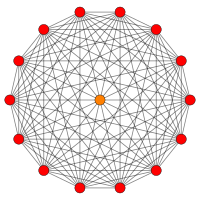
|
||||
| [16] | [14] | ||||
| 6 _ | B5 _ | ||||

|
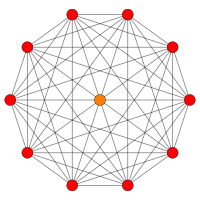
|
||||
| [12] | [10] | ||||
| 4 _ | B3 _ | B2 _ | |||

|
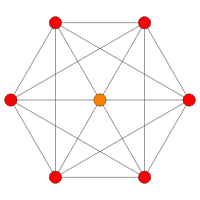
|
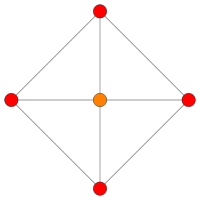
|
|||
| [8] | [6] | [4] | |||
| 7 _ | 5 _ | 3 _ | |||

|

|

|
|||
| [8] | [6] | [4] | |||
Jest używany w swojej naprzemiennej postaci 5 11 z 8-simplexem, aby utworzyć plaster miodu 5 21 .
-
HSM Coxeter :
- HSM Coxeter, Regularne Polytopes , wydanie 3, Dover, Nowy Jork, 1973
-
Kaleidoscopes: Selected Writings of HSM Coxeter , pod redakcją F. Arthura Sherka, Petera McMullena, Anthony'ego C. Thompsona, Asia Ivic Weiss, Wiley-Interscience Publication, 1995, ISBN 978-0-471-01003-6 [1]
- (Papier 22) HSM Coxeter, Regularne i półregularne Polytopes I , [Math. Zeit. 46 (1940) 380-407, MR 2,10]
- (Papier 23) HSM Coxeter, Regularne i półregularne Polytopes II , [Math. Zeit. 188 (1985) 559-591]
- (Papier 24) HSM Coxeter, Regularne i półregularne Polytopy III , [Math. Zeit. 200 (1988) 3-45]
-
Norman Johnson Uniform Polytopes , Rękopis (1991)
- NW Johnson: Theory of Uniform Polytopes and Honeycombs , Ph.D.
- Klitzing, Richard. „Jednolite polytopy 8D (polyzetta) x3o3o3o3o3o3o4o - ek” .
Linki zewnętrzne
- Olszewski, Jerzy. „Krzyż polytope” . Glosariusz hiperprzestrzeni . Zarchiwizowane od oryginału w dniu 4 lutego 2007 r.
- Polytopy o różnych wymiarach
- Słowniczek wielowymiarowy
